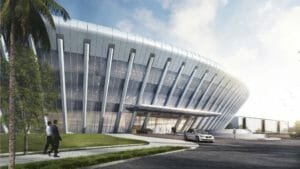Building a Pediatric Hospital
At a pediatric hospital, the healing process should begin as soon as Mom or Dad drives up the driveway to look for a parking space. That’s where it all begins for the young patient and his or her family. And that’s where the differences begin when it comes to building a pediatric hospital, as compared to a “traditional” facility.
After completing three pediatric hospitals in Arizona within the past two years, Kitchell has refined strategies and tactics regarding these special hospitals, which have become ever more complex as technology advances and medical care evolves to treat increasingly acute patients.
Over the past two years, Kitchell has been CMAR (Construction Management At Risk) for Banner Desert Medical Center’s Cardon Children’s Hospital in Mesa, the recently opened Diamond Children’s Center at University Medical Center in Tucson and Phoenix Children’s Hospital.
Fortunately for hospital architects, engineers and builders, there is solid research to draw upon to guide the development of the most effective, functional children’s medical campuses.
Transformation by Design, produced by the National Association of Children’s Hospitals and Related Institutions (NACHRI), reviewed 320 evidence-based design studies published in academic literature. This report concludes “the physical environment of healthcare settings affects the clinical, physiological, psychosocial and safety outcomes among child patients and their families.”
The No. 1 goal as builders is to produce a stress-reducing, healing environment, while reducing the chances of infections and medical errors. There are several issues to consider when constructing pediatric hospitals:
Pediatric IPD
Bringing all stakeholders, including young patients who are “frequent fliers” at the hospitals, as well as owners, architects, engineers and contractors, into the pre-design phase has proven highly beneficial to construction outcomes. The theme, Through the Eyes of a Child, drove the entire Cardon Children’s Hospital project. And Diamond Children’s Medical Center hosts two ongoing advisory councils comprised of children and teens. Initiatives like these ensure children’s perspectives are always front and center.
 Motifs/Theming
Motifs/Theming
Theming to engage and entertain is certainly the most obvious defining characteristic of a pediatric hospital, but how to achieve the right tone, taking age-appropriateness into consideration, is far from obvious. Creating a sense of comfort and fun for a toddler is very different than creating a sense of coziness and relaxation for a teenager, both of whom will be sharing space. Some hospitals cultivate a playground/amusement park feel, while others try to maintain a more staid, yet welcoming youth-driven atmosphere. Cutting-edge technology is being utilized to bring “edutainment” and social media options directly into patient rooms.
Noise Maintenance
A quiet environment may reduce recovery time. Rubber flooring with high STC acoustical ratings has replaced vinyl sheeting predominantly used in the past.
Creative Materials
Multiple textures, varied artwork and soothing finishes reinforce the healing process. Highly durable, vibrantly colored terrazzo flooring is currently very popular. Natural elements, such as whimsical water features, are a dynamic way to bring the outside in (and engage the senses of hearing, smell and touch, as well as sight) to what has traditionally been a cold and sterile place.
Lighting
Studies show natural lighting helps babies heal faster. The industry is coming up with creative ways to integrate natural lighting with state-of-the-art LED interior lighting that enables healthcare staff to perform their jobs effectively, but is also pleasing to the patients — a huge leap forward from the harsh cathode lighting of the past.
Pods vs. Private Rooms
What is better for the youngest patient and family, a private room or a pod arrangement? This is actively being discussed right now. The benefits of private rooms seem obvious, but healthcare experts value the interactive nature of community-oriented pod set-ups, which are conducive to family-to-family interaction. After all, no one can relate to a family’s ordeal better than another family simultaneously going through the same challenges. Current designs have trended toward private rooms, but family areas, clinical programs and hospital-directed family support groups have promoted the “community” healing benefit for the young patients.
Space
At pediatric hospitals, more space is needed to accommodate more than one family member. For example, ample space is available for fold-out beds and private guest showers in patient rooms. In general, there are more “soft” spaces for siblings and other family members. The most critical issues to consider when constructing or expanding a pediatric hospital? All involved need to minimize negative impacts to the recovering patients. “The patient comes first,” says Mike Wolfe, a Kitchell project director. “If you or a loved one had the misfortune to be in a hospital that was undergoing construction, would you want a construction crew to be jack-hammering concrete in the middle of the night? Working in and around children’s hospitals requires extra sensitivity and flexibility to work around patients’ needs.”
[stextbox id=”grey”]
Some Unique-to-Pediatric-Hospital Construction Features
- Expanded kitchens to fulfill children’s menu preferences (pizza, stir-fry, etc.)
- Treatment rooms on each floor so patient bedrooms are “pain-free” safe havens
- Wireless Internet access for each patient and their families
- Interactive play/family spaces on each floor
- Teen activity rooms
- Lactation rooms
- Auditorium/stages for children to see performances, concerts, graduations
or have parties - Meditation rooms
- Healing gardens
- Toy stores
[/stextbox]



